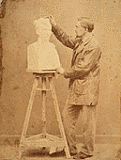AUGUSTE RODIN
- his life, his work (1)
|
|
|
|
|
12.11.1840
|
Auguste Rodin is born in Paris as the second child of Jean-Baptiste Rodin, an employee of the
Préfecture de Police (later Inspector), 38 years
old, and Marie Cheffer, 34 years old. His sister Maria is two years older;
they have an unusal close relationship.
|
|
1844
|
Rose Beuret is born in June.
|
|
18.8.1850
|
Day of the death of Honoré de Balzac.
|
|
1851-53
|
Auguste attends the boarding school of his uncle Alexandre Rodin in
Beauvais. He
is shy and a poor student. Afterwards he remembered:
"I could not see the figures on the blackboard
[...]. I have always been shortsighted. As a child I did not know what was the matter and I hated mathematics because I could not see."
|
|
1854-57
|
At the age of 14, he becomes a student at the former Petite École in the
Quartier Latin, now named the École Impériale Spéciale de Dessin et de Mathématiques; in the class of Horace Lecoq de Boisbaudran he permanently
makes drawings e.g. copies after the French
artists of the Eighteenth Century; under his fellow pupils are Jules Dalou and Henri Fantin-Latour.
Once he told his friend Dujardin-Beaumetz:
"When I was very young, as far as I can remember, I made drawings.
A grocer patronized by my mother used to wrap his prunes in paper bags made of pages torn from illustrated books, or even prints. I copied them;
they were my first models."
In spite of his great diligence, neither his teachers nor his fellow pupils certify him virtuosity or special artistic skills.
|
|
1857
|
Charles Baudelaire publishes his collection of poems 'Les Fleurs du Mal';
a court case is instituted because of the sexual offence in his work; he
has to remove six of his poems.
|
|
1857
|
Auguste Rodin fails for the third time at the entrance examination of
the École des Beaux-Arts. For the rest of his life, Rodin will
cultivate an aversion against the sterility and artificiality of
conventional academic art.
|
|
1858-62
|
 Rodin works now as a bricklayer and modeller for several building
contractors, restaurateurs and ornamentalists employed by the architect Haussman
who has the commission to renew the townscape of Paris under Napoléon
III.
Rodin's later comment: Rodin works now as a bricklayer and modeller for several building
contractors, restaurateurs and ornamentalists employed by the architect Haussman
who has the commission to renew the townscape of Paris under Napoléon
III.
Rodin's later comment:
"In my opinion too, this was certainly inferior work. But I had to learn at this development process that this point of view was incorrect."
|
|
1860
|
He finishes a bust of his father in Neoclassical manner; it is the first surviving sculpture of Rodin.
|
|
1862
|
 The sudden and early death of his sister Maria, 25 years old, upsets him so, that he is looking for consolation at the recently founded order of
Les Pères du Saint-Sacrément. The sudden and early death of his sister Maria, 25 years old, upsets him so, that he is looking for consolation at the recently founded order of
Les Pères du Saint-Sacrément.
|
|
1863
|
 Rodin models a bust of the founder of the order, Father Eymard, who recognizes
Rodin´s true vocation;
he advises him to leave the order and live for his talent. Rodin models a bust of the founder of the order, Father Eymard, who recognizes
Rodin´s true vocation;
he advises him to leave the order and live for his talent.
He becomes a member of L'Union Centrale des Arts Décoratifs, to
which Delacroix, Ingres, Lecoq de Boisbaudran, Dumas pére and Théophile
Gautier belong as well. There, he meets the famous sculptor Jean-Baptiste
Carpeaux.
After works in gothic style in Strasbourg, he returns to Paris.
|
|
1863
|
Manet's painting 'Déjeuner sur l'herbe' is
refused by the Salon.
Napoléon III orders a special exhibition of works refused by the Academy:
The Salon des Refusés.
|
|
1864
|
 First studio in the Rue le Brun, Paris. First studio in the Rue le Brun, Paris.
He creates a portrait of a man from the neighbourhood, Bibi. According to a
story later propagated by Rodin, the sculptor was too poor to heat his
atelier overnight, so that the clay model froze and the back side of the
head dropped off. 'The Mask of Man with the Broken Nose' is rejected by the Jury of the Salon, presumably because
the astounding realism did not fit the academic aesthetic ideals.
 At the
Musée d‘Histoire Naturelle he attends Antoine-Louis Barye's courses in animal
anatomy; but there he is more interested in the enthusiasm of his teacher for details than in the studies of
animals. He also attends anatomy classes at the École de Médicine.
At the
Musée d‘Histoire Naturelle he attends Antoine-Louis Barye's courses in animal
anatomy; but there he is more interested in the enthusiasm of his teacher for details than in the studies of
animals. He also attends anatomy classes at the École de Médicine.
During the next six years he works together with his employer, the
sculptor Albert Carrier-Belleuse.
During his work for the Théatre des Gobelins, he meets the pretty seamstress Rose
Beuret; she becomes his model and companion through life. When he is
travelling or working abroad, she looks after his precious clay models and
keeps them wet with damp cloths.
|
|
08.12.1864
|
Camille Rosalie Claudel is born in Villeneuve-sur-Fère, as
daughter of Louis-Prosper Claudel and Louise Cerveaux.
|
|


|